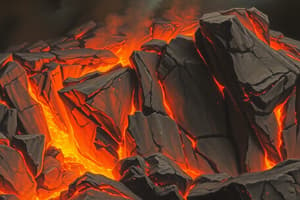Podcast
Questions and Answers
What type of rocks form when magma hardens beneath the Earth's surface?
What type of rocks form when magma hardens beneath the Earth's surface?
- Extrusive Igneous Rocks
- Intrusive Igneous Rocks (correct)
- Sedimentary Rocks
- Metamorphic Rocks
What type of rocks form when lava hardens?
What type of rocks form when lava hardens?
- Metamorphic Rocks
- Extrusive Igneous Rocks (correct)
- Intrusive Igneous Rocks
- Sedimentary Rocks
What is the difference between lava and magma?
What is the difference between lava and magma?
Magma is molten material beneath the Earth's crust; when it reaches the surface, it is called lava.
What are two characteristics used to classify igneous rocks?
What are two characteristics used to classify igneous rocks?
How are igneous rocks classified by texture?
How are igneous rocks classified by texture?
Explain coarse-grained texture.
Explain coarse-grained texture.
Explain fine-grained texture.
Explain fine-grained texture.
Explain glassy texture.
Explain glassy texture.
Explain porphyritic texture.
Explain porphyritic texture.
Explain granitic composition.
Explain granitic composition.
Explain basaltic composition.
Explain basaltic composition.
Explain andesitic composition.
Explain andesitic composition.
Explain ultramafic composition.
Explain ultramafic composition.
Flashcards are hidden until you start studying
Study Notes
Igneous Rocks Overview
- Intrusive igneous rocks form from magma that solidifies beneath the Earth's surface.
- Extrusive igneous rocks form from lava that solidifies on the Earth's surface.
Magma vs. Lava
- Magma is molten material found beneath the Earth's crust, often accumulating in magma chambers.
- When magma erupts through a volcano, it is referred to as lava.
Classification of Igneous Rocks
- Igneous rocks are classified based on two primary characteristics: texture and composition.
Texture Classifications
- Coarse-grained texture: Results from slow cooling of magma or lava, leading to large crystal formations.
- Fine-grained texture: Results from rapid cooling, resulting in small, interconnected crystals.
- Glassy texture: Forms when lava is cooled rapidly during volcanic eruptions, preventing crystallization.
- Porphyritic texture: Develops when cooling conditions change quickly, producing varied crystal sizes.
Composition Classifications
- Granitic composition: Consists primarily of light-colored silicate minerals such as quartz and feldspar.
- Basaltic composition: Contains dark silicate minerals and plagioclase feldspar.
- Andesitic composition: Has mineral composition intermediate between basaltic and granitic rocks.
- Ultramafic composition: Nearly entirely composed of dark silicate minerals.
Studying That Suits You
Use AI to generate personalized quizzes and flashcards to suit your learning preferences.




